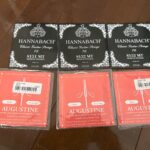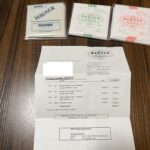I have been playing my Sakurai Masaki Maestro-RF (Raised Fingerboard Model) every day for about 5 years since I bought it, but I went to a music store to try guitars out and was shocked to see a guitar that everyone knows: “Hermann Hauser“. I bought it even though I thought it was an inappropriate instrument for me. I would like to write about how it came about and its sound.
- The process of purchasing Hauser III
- Bouight Hermann Hauser III Llobet Model
- Low tension and easy to play
- Sound quality appeal is that it is a “quiet instrument”
- Complex chords are not dumplings
- Rare “Llobet Model”
- Bracing without closing bar
- Warm-up operation is necessary to show its full potential
- Professional guitarists told me it sounds good, and they asked me what kind of instrument it is
- Beautiful spruce + Jacaranda specification
- Hauser’s own handwriting was found on the back of the sound board!
- The journey of the strings will have to be redone
- I can’t say I recommend it for everyone, but it’s the best instrument for me
The process of purchasing Hauser III
First, I would like to write about the process of purchasing Hauser III.
“The instrument is kind of curious”, at first
When I went to the music store to try out the guitars, the ones I initially intended to play were mainly modern instruments.
It is what we call a loud, easy to play, modern sounding instrument.
I have tried many such instruments, and I can honestly say that there was no instrument that was significantly better than the Sakurai RF that I use, for better or worse.
The instruments tested included so-called loud instruments such as Simon Marty, Walter Verreydt, and Mark Usherovich. I also tried instruments of traditional construction, such as Dominic Wurth and John Ray, as well as instruments of a earlier traditional construction, such as Manuel Velazquez and Reid Galbraith.
However, although I thought they all sounded good in their own way, I did not think they were overwhelmingly superior to the Sakurai RF. To be clear, they are all good instruments. There are numerous points where they are superior to Sakurai RF. However, I was not inclined to replace them.
When I told the clerk that I often played Baroque at such times, the Hauser III instrument appeared.
When I first played it, my impression was that it was a very plain instrument. Each of the aforementioned instruments is loud and flamboyant, and each has its own unique character. In contrast, the Hauser III was very plain.
If it were that plain, I would lose interest in it, but for some reason I can’t let it go. The more I play it, the more I enjoy it. I started to think, “Isn’t this a great instrument? But I didn’t buy it that day and went home.
Maybe I originally thought I was going to play a modern instrument and my mind didn’t switch.
Days of not being able to sleep at night last a week
Despite playing various guitars after returning home, the only one I could not forget was the Hauser III.
The more I thought about it, the more interested I became, and the more I looked into it, the more I wanted to play it.
And for the next week, I couldn’t sleep much. I couldn’t stop myself from wanting to play more.
To avoid any misunderstanding, I would write that the Sakurai RF is a good instrument and that playing different guitars has allowed me to bring out many more different expressions.
However, I felt that there was something about Hauser III that was appealing on a different level.
Tried a total of 5 Hauser guitars
I played a variety of Hause guitars, as each instrument has its own character. I added Kathrin Hauser and tried five Hauser guitars.
Tokyo is still amazing that there are so many Hauser guitars! I could not afford Hauser I and Hauser II, so I limited myself to Hauser III and Kathrin Hauser, but this is the number of Hauser guitars I could try.
Each instrument was good in its own way, but the Segovia model made by Hauser III, of which there were many, seemed to condense the sound inward rather than emit it forward. I thought the sound was also a little dark. However, it is a very attractive sound. In particular, the Hauser IIIs from the 80s were especially well played and full of flavor.
The Katrin Hauser had a hard sound, partly because it was an unplayed piece. It has Hauser’s character, but I preferred the III’s.
Finally, I decided to purchase the Hauser III Llobet model as soon as I tried it.
Bouight Hermann Hauser III Llobet Model
This Llobet model made by Hermann Hauser III was totally different from other Hauser guitars. I love it so much that I bought it as soon as I tried it.
Low tension and easy to play
My impression (delusion) of Hauser until I tried it was that it was difficult to play because of its high tension, and that it was hard to produce good sound.
However, when I actually tried it, the Hauser III was not that difficult to play and was easier to play than the Sakurai RF. This may be due to the higher string height of the Sakurai RF in its shipped condition, and therefore higher tension…. It was easier to play than the other instruments I tried.
Kathrin Hauser was a bit hard to play, but this may be a matter of playing in.
The Hauser III was not as difficult to play as expected, but the ease of playing the Llobet model was exceptional.
In terms of specifications, the string length is 645 mm, and the body size is small and thin, making the instrument easy to control and hold.
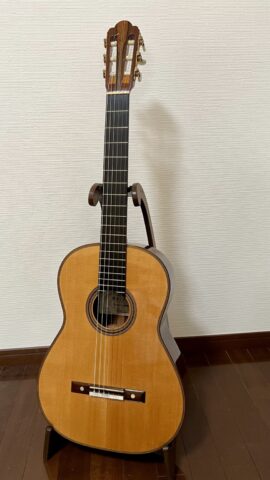
It is light because it is small. It is not easy to play in terms of price, but as an instrument, it is easy and fun to play anyway.
Regardless of the specs, it is so easy to produce sound when you touch it, and it is just fun to play. The sound is bright and never gives the impression of a serious German-made instrument.
I absolutely had to buy this one! So I traded in my Sakurai RF for this Hauser III Llobet model.
Sound quality appeal is that it is a “quiet instrument”
When I took it home and played it, I found its greatest appeal to be its quietness.
Modern instruments are just as loud and gorgeous. Even when played lightly, they produce a loud sound and add a gorgeous sense of color.
That may be fine for some music, but the Baroque, Classical, and Romantic music I often play is not necessarily good music with all those sounds. Sometimes I have to get used to louder and more spectacular sounds, but sometimes I need quieter sounds.
In such a case, Hauser III sounds just as you expect it to. It is a quiet but present sound.
Of course, it can also produce a strong and gorgeous sound, and it can be said that it is an instrument that can make the player’s thoughts into sound.
The sound has good stretch and can reflect the composer’s intention well even in baroque, where sounds are intricately intertwined (whether I can do it or not, but the instrument can). The lack of flamboyance and the good sound separation with few incidental sounds are also well suited for music such as baroque.
As a result of these features, it is fun to play and less tiring. You will not get bored even if you play for a long time, and you will keep coming up with ideas for playing this way and that.
To use an analogy, instruments these days are like marbled meat, premium beer, and daiginjo sake. They are delicious and gorgeous, and you can tell their quality immediately after playing them. In contrast, Hauser is like fine red meat, craft beer, and Honjozo sake.
By the way, the volume is not low. It is loud enough.
Complex chords are not dumplings
One of the reasons why Hauser is said to be suitable for baroque music is that when chords are played, each note sounds solid and not clustered together.
This characteristic is also firmly evident in the Hauser I purchased, for example, the sound when playing the chords at the beginning of Bach’s Chaconne is completely different.
Good separation may sound like a thin sound, but it is not, and the sound itself is rather thick.
I wonder why the sound is so fat and yet so well separated, but perhaps that is why Hauser is called a masterpiece.
Rare “Llobet Model”
Hauser III guitars come in a variety of models.
- Segovia model: typical instrument, relatively large body
- Bream model: the model Bream used? A little smaller
- Llobet model: Smaller body, designed based on the Torres model used by Llobet
- Jubilee model: limited edition luxury products
Of these, the Segovia model can be found in various music stores, and the Bream model is also found there. The Jubilee model is a limited edition, so it is not surprising that it is hard to find, and the Llobet model seems to be quite rare.
According to the owner of the store where I bought it, he has been running the store for about 40 years and has only handled about 2 Hauser IIIs of the Llobet model. If it were not so popular, I think it would be better to have more on the market, so are there only a few produced?
Bracing without closing bar
I checked the bracing bar, and found that it had the Hauser-like specification of seven force-mechanical bars plus a bridged board, but there was no closing bar, a “V” shaped bracing bars that receives the seven force-mechanical bars:
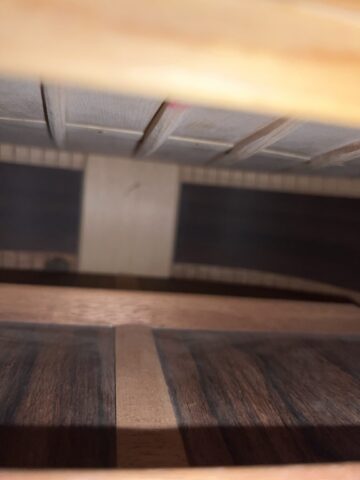
In an article in the February 2011 issue of Gendai Guitar (No.562), there was a story that Segovia raved about a guitar built by Hauser I, but was told to take the closing bar, and that the guitar was eventually given to Llobet. So, the guitar may be the origin of the “Llobet model”.
Warm-up operation is necessary to show its full potential
Not only the Hauser III that I purchased, but all Hauser instruments, including the Katrin Hauser, do not sound very good right after you start playing them.
I have the impression that after playing for a while, the engine gradually starts to rev up. It can be said that this instrument needs to be warmed up.
The Sakurai RF sounded rather quickly, which is totally different. Is this another difference between traditional and modern instruments?
It will be necessary to check the tone of the instrument along with finger training before playing each piece.
Professional guitarists told me it sounds good, and they asked me what kind of instrument it is
Since I switched to the Hauser III, I have received more and more comments about the beautiful sound when I play in public.
Moreover, even professional guitarists told me it had a good sound, and often asked me what kind of instrument I played.
It is both pleasant and sad when I say, “I am Hauser III,” and the response is, “Oh, I knew it….
I want to be able to produce a beautiful sound regardless of the instrument, or even better than the instrument’s reputation.
Beautiful spruce + Jacaranda specification
The Hauser III Llobet model I purchased is dated 2004 on the label.
The year on the Hauser label is the year he started building the instrument, and it was completed a year or two later. I am personally happy that it is just about the year my wife and I got married.
It is said that the charm of Hermann Hauser lies in the quality of its materials, and my instrument is also sighingly beautiful.
The tone wood is not an intense bear claw, but it has a well-defined horizontal wave pattern, suggesting that it is good material.
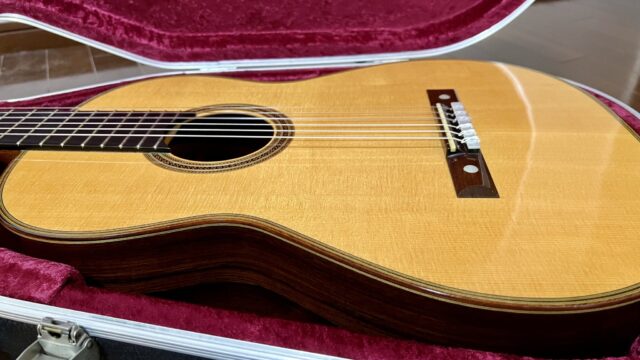
The Jacaranda on the sideboards and backboards is also great, but I can’t get a good shot of it with my camera…
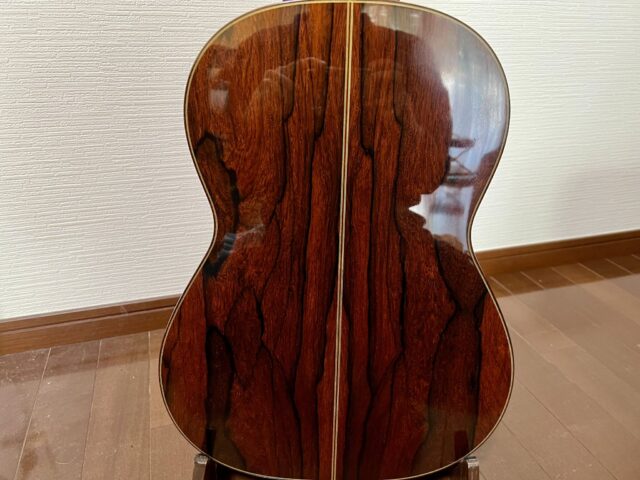
The bridge has a shell inlay common in the Hauser I era.
I thought it was a luxury item if it contained this, but the shop owner said that was not the case. Still, the golden spruce pattern is beautiful….
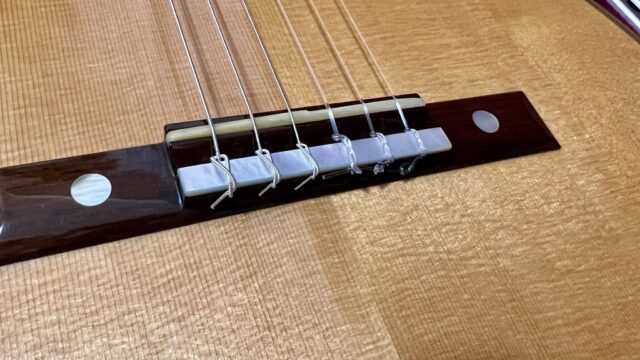
The pegs are Rischel. I heard that they stopped manufacturing pegs, but I wonder if they will be replaced with others when they break…. I hope there are replacement parts left.
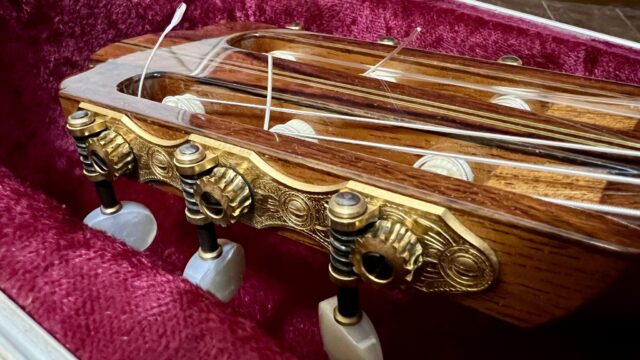
This is my first time to use Rischel, but it is stiffer than Gotoh and other brands. Although it is stiffer, it is more accurate, and I felt that it is easier to make fine adjustments because of that.
Since the guitar is small, it is fugly when placed in a regular case. For this reason, the case that came with it was a smaller HISCOX. Although it is a hard case, it is lighter than the Sakurai RF dedicated case I have been using (laugh).
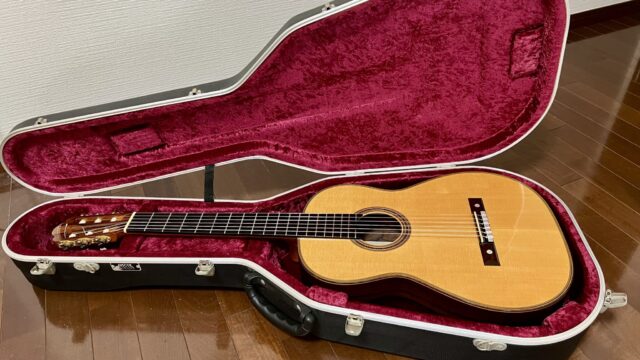
Hauser’s own handwriting was found on the back of the sound board!
While checking things out, I found Hauser’s own handwriting on the back of the sound board.
Please see this article for more details:
The journey of the strings will have to be redone
The Sakurai RF and Hermann Hauser III that I have been using are completely different, or rather the exact opposite instruments, so the string matching seems to be completely different.
I have reviewed over 70 different strings on this site to determine which ones are a good match.
With the change of instruments, it seems that I will have to start all over again. Well, that’s fun too.
By the way, I am currently using Augustine red for the bass strings and Hannabach green for the treble strings and they sound good. Would lower tension strings fit better?
I am also interested in the Hermann Hauser strings.
PS: I actually strung the Hermann Hauser strings and found them to be a great match.
I can’t say I recommend it for everyone, but it’s the best instrument for me
I have written about the appeal of the Hermann Hauser III Llobet model I bought, but I cannot necessarily say that I recommend it to everyone.
Since the impression of a quick play is subdued, you may not be able to notice its charms in a short trial run.
In my case, although I had played Sakurai RF for five years and loved its gorgeous sound, I also felt somewhat tired.
Maybe that’s also why I liked Hauser so much. It is the best instrument for me. According to the shop owner, it still sounds young, so I hope to see it evolve.
If you are tired of modern sounding instruments, please try Hauser.
I will never buy another instrument. … Did I say the same thing when I bought Sakurai RF?


![現代ギター 2011年 02月号 [雑誌]](https://m.media-amazon.com/images/I/51KdxmdrBiL._SL160_.jpg)





